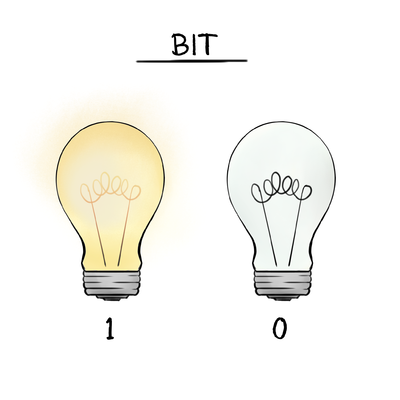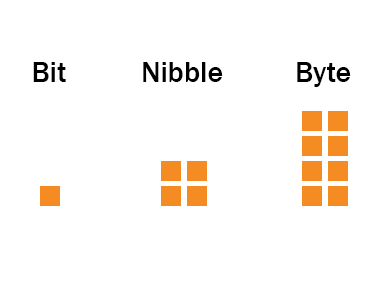Difference between revisions of "Bit"
esse quam videri
(→Binary Math) |
|||
| (10 intermediate revisions by 2 users not shown) | |||
| Line 1: | Line 1: | ||
=Definition= | =Definition= | ||
| + | Also known as a '''B'''inary dig'''IT''', is the smallest in size and is either a 1 or a 0. | ||
| + | |||
| + | =What does this mean= | ||
| + | It's basically the smallest form of data storage you can think of. It is either present or absent, true or false, yes or no, 1 or 0. | ||
| + | |||
| + | [[File:BitVisual.png | 400px]] | ||
=Relevance= | =Relevance= | ||
| + | * [[Binary]] | ||
| + | * [[Base 2]] | ||
=Explanation= | =Explanation= | ||
| + | Everything in a computer is 0's and 1's. The bit stores just a 0 or 1: it's the smallest building block of storage. | ||
| + | A bit is a computer storage reference, whereas [[Binary]] can refer to the number system as well. We mostly use Bit for [[Base 2]] calculations. | ||
| + | 1 bit of data can only hold 0 or 1. 2 bits of data can hold 2^2 or 00, 01, 10 or 11. So, 8-bits of data can hold 256 patterns of binary digits (0 or 1). | ||
| − | + | [[File:Bit2.png | 650 px]] [[File:BitNibByte.png | 400px]] | |
| + | |||
| + | Credits: https://web.stanford.edu/class/cs101/bits-bytes.html | ||
| − | |||
== See also == | == See also == | ||
| − | + | * [[Base 2]] | |
* [[Binary]] | * [[Binary]] | ||
* [[Numeral Systems]] | * [[Numeral Systems]] | ||
| − | |||
| − | |||
| − | |||
| − | |||
| − | |||
| − | |||
Latest revision as of 15:14, 8 August 2019
Definition
Also known as a Binary digIT, is the smallest in size and is either a 1 or a 0.
What does this mean
It's basically the smallest form of data storage you can think of. It is either present or absent, true or false, yes or no, 1 or 0.
Relevance
Explanation
Everything in a computer is 0's and 1's. The bit stores just a 0 or 1: it's the smallest building block of storage.
A bit is a computer storage reference, whereas Binary can refer to the number system as well. We mostly use Bit for Base 2 calculations. 1 bit of data can only hold 0 or 1. 2 bits of data can hold 2^2 or 00, 01, 10 or 11. So, 8-bits of data can hold 256 patterns of binary digits (0 or 1).
Credits: https://web.stanford.edu/class/cs101/bits-bytes.html


